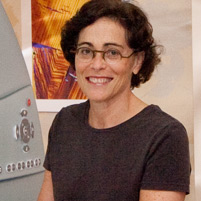Brain Sync

Marlene Behrmann
Scientists are one step closer to solving the mysteries of autism.In a recent imaging study of sleeping toddlers, they found some to have a diminished ability of the two brain hemispheres to "sync" with one another.
The discovery could be a powerful new biological marker of autism — one that could soon enable an autism diagnosis at a very young age.
"With this study, we have made significant scientific progress in understanding autism at the genetic, behavioral and neurobiological levels," said Carnegie Mellon University's Marlene Behrmann.
Behrmann was part of a team of researchers who conducted the study, which included scientists from the University of California, San Diego Autism Center of Excellence and Weizmann Institute in Israel.
"This work is one piece of a complicated puzzle as we try to identify and characterize potential biological markers. We hope to connect this work with geneticists to develop concrete descriptors as well as determining if the markers will predict different autistic patterns as children grow up."
Behrmann, a professor of psychology at CMU, has made other groundbreaking autism discoveries using brain imaging.
This study, which is published in Neuron, shows that language areas located in the right and left sides of the brain are less synchronized in toddlers with autism than in toddlers displaying either language delay problems or typical development.
Within the autism group, the strength of synchronization was associated with individual language and communication abilities.
In other words, the weaker the synchronization, the more severe the communication difficulties.
"Neural synchronization refers to the coordinated timing of neural activity across distinct brain areas," said Ilan Dinstein, first author of the study.
Dinstein is a neurobiologist at the Weizmann Institute of Science in Rehovot, Israel, and a member of the UCSD Autism Center of Excellence.
"In a normal brain, neurons in separate areas belonging to a system with a particular function, such as vision or language, always stay in sync, even during sleep," Dinstein explained.
"Our study shows that in most brains of toddlers with autism this 'sync' is significantly weaker in brain areas that are responsible for language and communication abilities."
Dinstein added, "Many things need to be set up right during brain development to enable normal sync between different brain areas. The wiring between the brain areas needs to be right and the neurons within each brain area need to send and receive their messages properly."
The findings, if corroborated by further research, could have significant impact, Dinstein said.
The exact cause of autism remains unknown.
It is hypothesized, however, that the neurological disorder — which is marked by impaired social and communications skills, usually manifesting in the first few years of life — arises from the development of abnormal neural networks with irregular connectivity and synchronization.
In addition to Dinstein and Behrmann, the research team included Karen Pierce and Eric Courchesne, Autism Center of Excellence and the Department of Neurosciences, both at UCSD; Lisa Eyler, Autism Center of Excellence and Department of Psychiatry, UCSD; Stephanie Solso, Autism Center of Excellence, UCSD; Rafael Malach, Department of Neurobiology, Weizmann Institute of Science.
Funding for this study came, in part, from grants from the National Institute of Mental Health, the National Institutes of Health, the Israel Science Foundation and the Pennsylvania Department of Health.
Related Links: Neuron | Brain, Mind & Learning | Marlene Behrmann | More on Behrmann's Autism Work | Dept of Psychology
